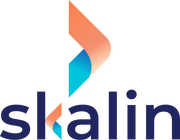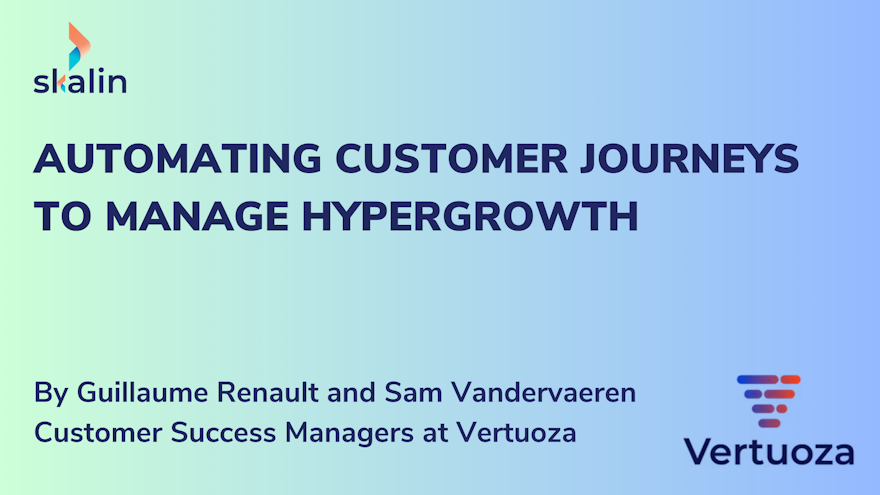Vertuoza currently servers 2,500 customers overseen by a dedicated team of around fifteen Customer Success Managers. Impressively, the company's customer number has tripled within just one year, signaling its status as a hyper-growth SaaS enterprise. Notably, Vertuoza's remarkable achievements were recognized with the esteemed title of Scale-up of the Year 2023 in Belgium.
Guillaume Renault and Sam Vandervaeren, Customer Success Managers, offer an insider's perspective on the strategic initiatives deployed to enhance the user experience through the implementation of automated customer journeys.
Can you introduce us to Vertuoza and tell us about your role within the company?
Vertuoza is a site monitoring solution for construction companies. The company originated within the construction firm owned by our boss, Antoni Di Filippo. Within his construction company, he initially designed his own internal management program, which he later developed further and offered to the entire construction sector.
- I'm Guillaume Renault, CSM at Vertuoza. I manage a portfolio of 150 to 200 customers. I was responsible for selecting the Skalin solution and implementing the program through automated workflows.
- I'm Sam Vandervaeren, also a CSM at Vertuoza. Much like Guillaume, I oversee a portfolio of 150 to 200 customers. My role primarily focuses on managing marketing initiatives and customer communications, with a special emphasis on crafting and delivering in-app messages. But I use Skalin every day!
This year, you have tripled your number of customers. What challenges have you had to overcome?
Sam: We have tripled our number of customers compared to the previous year, reaching around 2,500 customers. Our expansion is particularly notable in Europe. Recently, we've established offices in Paris and Switzerland, with plans to scale our team to 100 employees by the end of 2023.
In a phase of hypergrowth, our primary challenge is to work intelligently. We aim to establish increasingly efficient strategies through automation while upholding the quality of our work and maintaining a high level of human interaction with our customers. That's precisely why we opted to implement automated customer journeys with Skalin.
Which stages did you go through before implementing a Customer Success Platform?
We went through five major phases before implementing Skalin :
- We began in 2020 with Team Leader CRM for our sales operations, which we later extended to support functions as well.
- Then, we aimed to specialize each department while fostering synergy across the board. As a result, we transitioned our Support function from Team Leader to Intercom. Additionally, we utilize Intercom for in-app communications, banners, posts, and more.
- With these two tools, alongside numerous other supplementary tools, we encountered a lack of integration between solutions. We found ourselves juggling between 15 open tabs, navigating from one page to another. Primarily, we lacked a centralized solution for analyzing customer interactions and attributing them to specific team members. For instance, to check if a Sales representative had contacted a customer, we had to log into Team Leader, while responding to customers required us to switch to Intercom. And let's not forget about our overflowing mailbox...
- In July 2022, we transitioned to HubSpot to gain a comprehensive, detailed view, including email tracking capabilities, and more. The objective was to facilitate specialization within each department while maintaining seamless communication across all teams.
- Despite using Intercom for Support and HubSpot for Sales, Marketing, and CSM, we were still missing the critical 360° view we needed. Particularly, HubSpot lacked insights into how customers were engaging with our platform. This deficiency led to what we commonly referred to as a bottleneck. Teams were forced to navigate between 3-4 different tools to manage customer relationships, resulting in excessive time spent consolidating information. We consistently found ourselves lagging behind crucial data. It was at this juncture that we began exploring Customer Success Platforms.
How did you go about comparing the solutions?
We carefully evaluated several CSM solutions and promptly discovered Skalin. Skalin exceeded our expectations: we wanted a program that was easy to implement and seamlessly integrated with our existing tools.
Everything unfolded rapidly:
- In August, Skalin was launched, a swift process facilitated by its native integrations with Intercom and HubSpot.
- Come September, we made the decision to establish a dedicated Support team, allowing our Customer Success Managers (CSMs) to concentrate exclusively on ensuring success for our clients.
- Subsequently, we introduced our initial Playbooks. The concept was for Skalin to furnish us with insights and automatically generate tasks based on customer needs.
This setup eliminates the need for us to hunt down information. Skalin continuously analyzes our customers' usage and interactions, delivering pertinent information and associated action plans promptly, as per requirements!
What methodology was used to set up the Playbooks ?
Prior to implementing the Playbooks, it was essential to standardize the workflows for all CSMs while preserving the human element. Operating within the construction industry, a highly specialized sector, direct customer contact remains paramount to meeting their unique needs.
We've opted to automate specific communication tasks to prioritize the video conferences we schedule with our customers and our one-on-one follow-ups.
Our customers can generally be categorized into two main groups:
- Those who are in the onboarding phase, typically spanning from zero to two months.
- Subsequently, they transition into the adoption phase.
Automated processes during the onboarding phase
In the onboarding phase, CSMs become involved immediately after the contract is signed and the Vertuoza environment is made accessible. Our initial task is to conduct an introductory call and suggest a follow-up video session with screen sharing. Subsequently, we proceed with the 'start-up follow-up' to align with the customer's objectives. Throughout these initial two months, we provide extensive support to ensure a smooth start for our customers.
In addition to task assignments, Skalin notifies us if an onboarding customer hasn't logged in for at least 15 days. Once the primary objectives are accomplished, the customer transitions to the adoption phase.
Workflows set up during the adoption phase
For the adoption phase, it's assumed that customers are utilizing the application regularly. They have access to Support if needed. From the CSM perspective, we have two crucial touchpoints: at the midpoint of the subscription (six months), we schedule a call to ensure everything is going smoothly; then, a month before renewal, to proactively address any potential issues and prevent surprises.
Similar to the onboarding phase, an alert playbook notifies us if a customer hasn't submitted a quote for 20 days. In such cases, the customer receives two initial emails in an attempt to re-engage, without requiring CSM intervention. If there's no response, a task is created for the CSM to directly contact the customer.
Catch-up scenario for customers in difficulty
During this follow-up, we identify customers who may be feeling disoriented. They then undergo a catch-up process, involving a re-onboarding procedure to assess their current needs.
Additionally, we may encounter customers who have lost momentum and are hesitant to resume using Vertuoza. In such cases, we categorize them into four groups:
- Those who perceive it as too expensive.
- Those who believe there are functional limitations.
- Those who are not within our target market.
- Those who have become unresponsive, making it challenging to reach them via phone or email.
For each of these risk categories, we have a defined process outlined in the form of a Playbook.
What results have you achieved through the implementation of these automated systems?
- This organisation enables us to operate proactively rather than reactively, eliminating the 'fire brigade mode' that plagued us in the past. Gone are the days of wasting valuable time hunting for information.
- It really allows us to prioritise the customers we need to contact, customers who are onboarding, customers who are in a bit of a bind, and not to proactively contact customers for whom things are going really well. You can really focus on the customers who need it.
- You contact the right customer at the right time. That frees up a lot of mental work. Thanks to Skalin and these processes, we can devote ourselves to the 'real' Success, the one that brings value to the customer.
- And above all, we can handle more customers by CSM while maintaining this human contact. So we can organise our time better and be much more efficient.
At the same time, we have been able to free up 4 to 5 hours a week for projects. Each CS can develop the team or devote themselves to cross-functional tasks. Among these projects, for example, we have created an academy to record all the training material in the form of short videos of 5 to 10 minutes, which customers can follow at their own pace.
Any advice prior to setting up Playbooks?
Paradoxically, I would emphasize the importance of not attempting to automate everything. Firstly, because our customers value human interaction. Furthermore, the danger of automating excessively lies in the potential loss of a tangible understanding of our customers' needs and experiences.
Secondly, it's crucial not to cram everything into a single playbook. Making changes becomes far more manageable when adjustments are made within smaller, more focused components. Constantly overhauling the entire process every other week for minor tweaks isn't sustainable.

